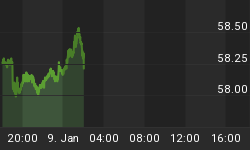Below is an extract from a commentary originally posted at www.speculative-investor.com on 11th March 2007.
Continuing with the "sometimes things are different" theme, during the current cycle there has clearly been a change in the relationship between stocks and commodities. Stocks and commodities have traditionally been either inversely correlated or uncorrelated asset classes, and as a result there has been a general tendency for professional money managers to use commodity-related investments to hedge their equity exposure. However, the following chart shows that over the past seven years there has been a strong positive correlation between the S&P500 Index (SPX) and the Industrial Metals Index (GYX). The GYX has clearly been the superior investment in that it fell by a much smaller percentage during 2000-2002 and rose by a much greater percentage thereafter, but the SPX and the GYX have essentially become plays on the same underlying global growth trend. Therefore, the idea that commodities in general and the industrial metals in particular can be used to offset stock market exposure needs to be binned, or at least re-considered.

We think the above-mentioned change has been due to the co-existence, throughout the world, of high inflation and low interest rates. Now, such a statement probably won't make sense to those who equate inflation with an increase in an index of consumer prices, but those who correctly define inflation as an increase in the money supply should already be aware of this strange co-existence.
Under normal circumstances the persistently high level of GLOBAL inflation since 1998 would long ago have caused the consumers of goods and services to experience a substantial loss of purchasing power, and this loss of purchasing power would have pushed interest rates to much higher levels. Higher interest rates would, in turn, have caused a global contraction in stock market price/earnings ratios, potentially leaving hard assets such as commodities as the sole beneficiaries of the inflation. During the current cycle, however, the tremendous upward pressure that would normally have been seen long ago in the prices of goods and services in response to rampant inflation (money supply growth) has been largely offset by a huge increase in productivity -- not the productivity of the "knowledge-based" US economy, mind you, but the productivity of the 'emerging world' (much of Asia, Latin America and Eastern Europe).
In other words, the effects of inflation have not shown up where they would normally have appeared thanks, to a large extent, to a dramatic increase in the quantity of low-cost goods and services produced by the 'emerging world'. The illusion that we are in a perpetual low-inflation environment -- an environment in which rising commodity prices can co-exist indefinitely with high stock market valuations -- has thus become popular. It has also helped, of course, that price-insensitive buyers with hundreds of billions of dollars at their disposal -- the governments of China and Japan being prime examples -- have chosen to buy enormous sums of US Government debt; but even such large-scale bond purchases would not have kept bond yields near multi-decade lows had inflation fears surged in response to rampant money-supply growth.
As an aside, some analysts refer to the downward pressure on consumer prices stemming from the increasingly large number of goods being made in countries with relatively low production costs as a deflationary force. However, this is the wrong way to look at it because anything that masks the effects of inflation paves the way for GREATER inflation in the future. The downward pressure on prices due to the globalisation of manufacturing is, in actuality, an INFLATIONARY force because by helping to keep the effects of inflation under wraps it creates the conditions under which much more inflation becomes possible.
Having just outlined a change that has occurred in the relationship between stocks and commodities and having attempted to explain why it has occurred, we are now going to risk adding a layer of confusion by broaching the possibility that the relationship will shift again within the coming 12 months -- back towards the way things used to be.
All government interventions designed to improve the workings of the economy have unintended adverse consequences, and in its efforts to bring about a massive increase in the production of ethanol the US Government might have unwittingly set in motion a chain of events that will simultaneously put upward pressure on commodities and downward pressure on financial assets (stocks and bonds). As discussed in previous TSI commentaries, the reason is that increases in grain prices resulting from the surge in ethanol-related demand for these commodities will lead to across-the-board increases in food prices. This, in turn, will likely cause inflation expectations to rise, thus putting downward pressure on bond prices (upward pressure on long-term interest rates) and prompting wage-earners to demand more money from their employers to offset cost-of-living increases. As a result, equity valuations will potentially be hit by the 'double whammy' of rising interest rates and shrinking profit margins.
In summary, the relationship between stocks and commodities has been different during the first seven years of the current cycle in that these two asset classes went from being inversely correlated or uncorrelated to being positively correlated. However, the stage has potentially been set for things to go back to the way they were.
















